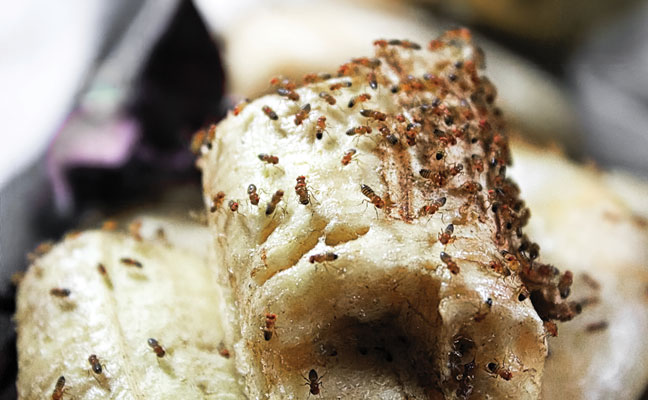
As the old joke goes, “Time flies like an arrow. Fruit flies like a banana.” PHOTO: AKCHAMCZUK/ISTOCK / GETTY IMAGES PLUS/GETTY IMAGES
Get to know the red-eyed fruit fly (Drosophila melanogaster).
Pest Management Professional magazine (PMP): Thank you for agreeing to be interviewed. You are widely recognized as being a pesky species, so our readers will enjoy hearing your comments.
Red-eyed fruit fly (RFF): Well, as vinegar flies, we thank you for your interest. It seems like termites, ants, bed bugs and rodents always are in the spotlight, so we appreciate being recognized as a “real” pest by PMP. Every pest management meeting focuses on those other pests, but we are often the forgotten one.
PMP: Tell us a little about yourself and your immediate family.
RFF: As a group, we love wet and fermenting foods. Overripe fruits, such as bananas, jellies, sugary items in unrinsed mops, and wet drains, are our favorites. When we deposit our eggs, the larvae do really well in these areas. Then they pupate and emerge as adults, and start the whole process again.
PMP: What are your most vulnerable areas?
RFF: Professionals are constantly overlooking the obvious. So many of them rely on fogging alone, but that only knocks down adults in the area. They’re not getting to the root cause. Ask any expert. I know, because at the last pest management meeting, I was attacking the fruit tray while an expert on flies was talking about how to manage us. Ironic, isn’t it?
PMP: We noticed you’re going by “red-eyed fruit fly” these days. What’s with the addition of the adjective?
RFF: We’ve tried to differentiate our identity as a “fruit fly” since about 1989, when the Mediterranean fruit fly (Ceratitis capitata), or medfly, nearly devastated the fruit crops in California. So more commonly now, the red-eyed fruit fly or vinegar fly is the term for us. We also have a cousin, the dark-eyed fruit fly (D. repleta), which has emerged as another hard-to-treat pest. They are not as connected to a unique food source, so “going to the source” is a bit more difficult.
PMP: The dark-eyed fruit fly seems to prefer more decayed organic materials and drains, correct?
RFF: That is a good distinction. They like areas closer to the floor and drains.
PMP: Let’s talk about control. What is the best method?
RFF: The basics of integrated pest management (IPM) work today. Inspect and find the source. Control is simply removal of our food source. If you have flies on a salad bar, for example, think about our habits. We are not strong fliers, and a little air current such as a slow fan will keep us away from the customers. For our dark-eyed cousins, foam the drains with a residual labeled for drains. Visit the account at off-hours to really get a good picture.
PMP: Why be so forthcoming about this? Usually the pests we interview are a bit guarded.
RFF: At the rate we reproduce, we are not worried.
PMP: Sun Tzu, in The Art of War, said “Do not repeat the tactics which have gained you one victory, but let your methods be regulated by the infinite variety of circumstances.” Would you agree?
RFF (looking around for a hasty exit): That’s right. Be creative and use the concepts of IPM. Don’t depend on one method.
PMP: Thank you for your time. By the way, where are you going in such a hurry?
RFF: Gotta go. Banana’s calling.
BAUMANN, a PMP Hall of Famer (Class of 2013), is VP of technical services and regulatory affairs for Nisus Corp., Rockford, Tenn. He can be reached at gregb@nisuscorp.com.
The post An interview with a red-eyed fruit fly appeared first on Pest Management Professional.
from Pest Management Professional https://www.mypmp.net/2020/06/23/an-interview-with-a-red-eyed-fruit-fly/
Sacramento CA
No comments:
Post a Comment